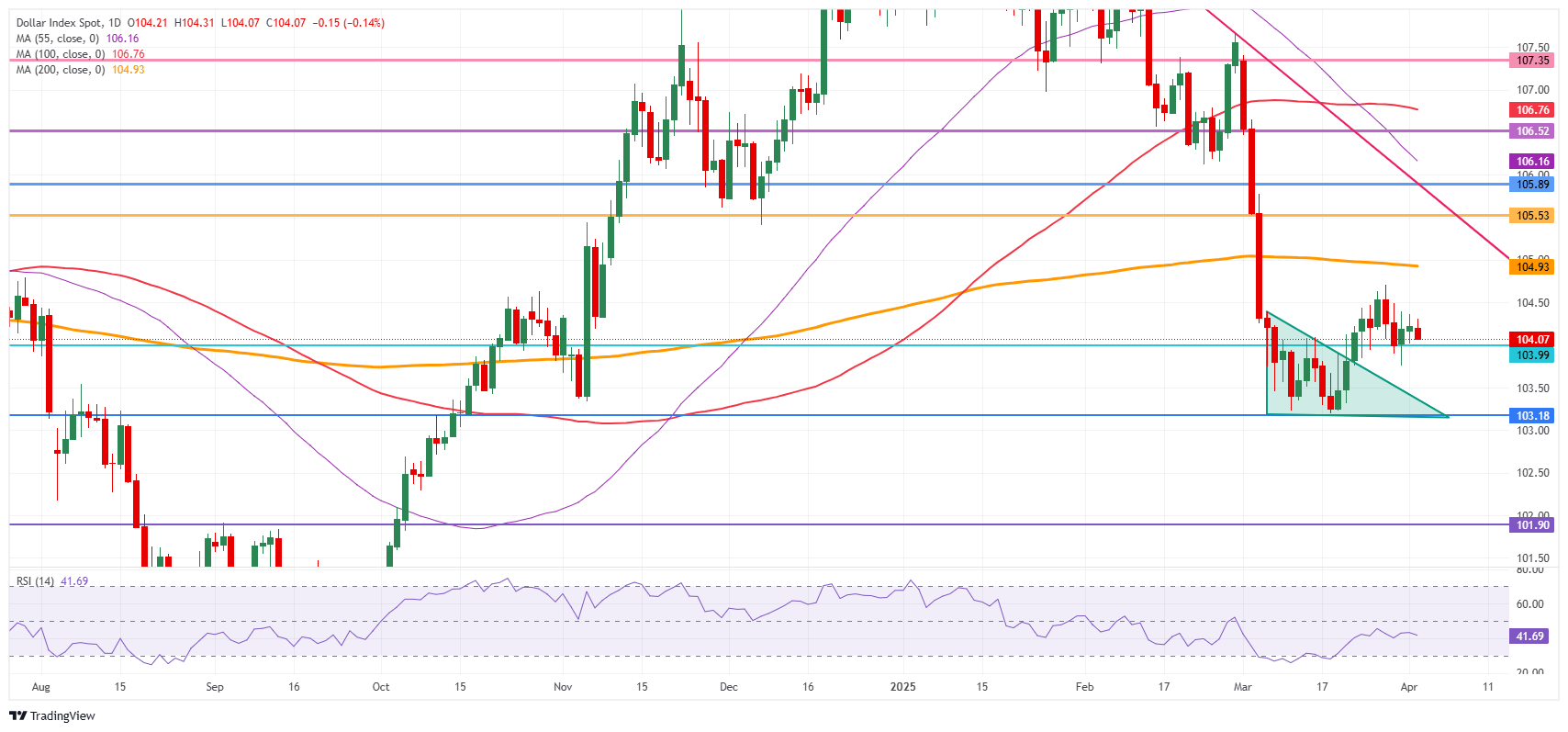- The Greenback remains stable against most major peers on Wednesday.
- US President Trump is set to announce reciprocal tariffs on Wednesday.
- The US Dollar Index trades stable around 104.10, while looking for any sort of driver.
The US Dollar Index (DXY), which tracks the performance of the US Dollar (USD) against six major currencies, consolidates for a second day in a row this week and hovers near 104.20 at the time of writing on Wednesday. The Greenback remains sidelined just hours before United States (US) President Donald Trump announces the reciprocal tariff implementation at the White House at 20:00 GMT. The White House and the Trump administration are very sketchy in details, and until now, it remains unclear what the tariffs will mean for markets.
On the economic data releases, this Wednesday’s main event will be the Automatic Data Processing (ADP) private sector employment data. As per usual in the Nonfarm Payrolls (NFP) week, the ADP number precedes the official NFP number from the Bureau of Labor Statistics (BLS). Although there is no real correlation between the NFP and the ADP numbers for the private sector, it could set the tone for expectations for Friday.
Daily digest market movers: ADP warm up towards NFP
- At 12:15 GMT, the ADP Employment Change data for March is due. Expectations are for a jump to 105,000 new employment compared to 77,000 in February.
- At 14:00 GMT, the February Factory Orders data will be released. Expectations are for a softer increase of 0.5% compared to the previous 1.7% seen in January.
- At 20:00 GMT, the main event for this Wednesday, US President Donald Trump will announce wide-ranging tariffs in an event he named “Liberation Day.” The moves could significantly affect global trade and financial assets.
- Equities are in the red across the board and the globe. Overall, there are minor losses in Equities, while Europe faces the most substantial ones with the German Dax down over 1%.
- According to the CME Fedwatch Tool, the probability of interest rates remaining at the current range of 4.25%-4.50% in May’s meeting is 85.5%. For June’s meeting, the odds for borrowing costs being lower stand at 74.4%.
- The US 10-year yield trades around 4.17%, just above its fresh three-week low.
US Dollar Index Technical Analysis: Unclear impact of ‘Liberation Day’
The US Dollar Index (DXY) could see again no big moves or changes even after Trump’s announcement of “Liberation Day”. Traders are still left in the dark about the impact of all these levies and tariffs on the US and the global economy. While a local US recession would see a substantially lower US Dollar, a global slowdown would benefit and strengthen the Greenback as a safe haven asset.
In that case, a return to the 105.00 round level could still occur in the coming days, with the 200-day Simple Moving Average (SMA) roughly converging at that point and reinforcing this area as a strong resistance at 104.93. Once broken through that zone, a string of pivotal levels, such as 105.53 and 105.89, could limit the upward momentum.
On the downside, the 104.00 round level is the first nearby support, although it looks bleak after being tested since Friday. If that level does not hold, the DXY risks falling back into that March range between 104.00 and 103.00. Once the lower end at 103.00 gives way, watch out for 101.90 on the downside.

US Dollar Index: Daily Chart
US-China Trade War FAQs
Generally speaking, a trade war is an economic conflict between two or more countries due to extreme protectionism on one end. It implies the creation of trade barriers, such as tariffs, which result in counter-barriers, escalating import costs, and hence the cost of living.
An economic conflict between the United States (US) and China began early in 2018, when President Donald Trump set trade barriers on China, claiming unfair commercial practices and intellectual property theft from the Asian giant. China took retaliatory action, imposing tariffs on multiple US goods, such as automobiles and soybeans. Tensions escalated until the two countries signed the US-China Phase One trade deal in January 2020. The agreement required structural reforms and other changes to China’s economic and trade regime and pretended to restore stability and trust between the two nations. However, the Coronavirus pandemic took the focus out of the conflict. Yet, it is worth mentioning that President Joe Biden, who took office after Trump, kept tariffs in place and even added some additional levies.
The return of Donald Trump to the White House as the 47th US President has sparked a fresh wave of tensions between the two countries. During the 2024 election campaign, Trump pledged to impose 60% tariffs on China once he returned to office, which he did on January 20, 2025. With Trump back, the US-China trade war is meant to resume where it was left, with tit-for-tat policies affecting the global economic landscape amid disruptions in global supply chains, resulting in a reduction in spending, particularly investment, and directly feeding into the Consumer Price Index inflation.

